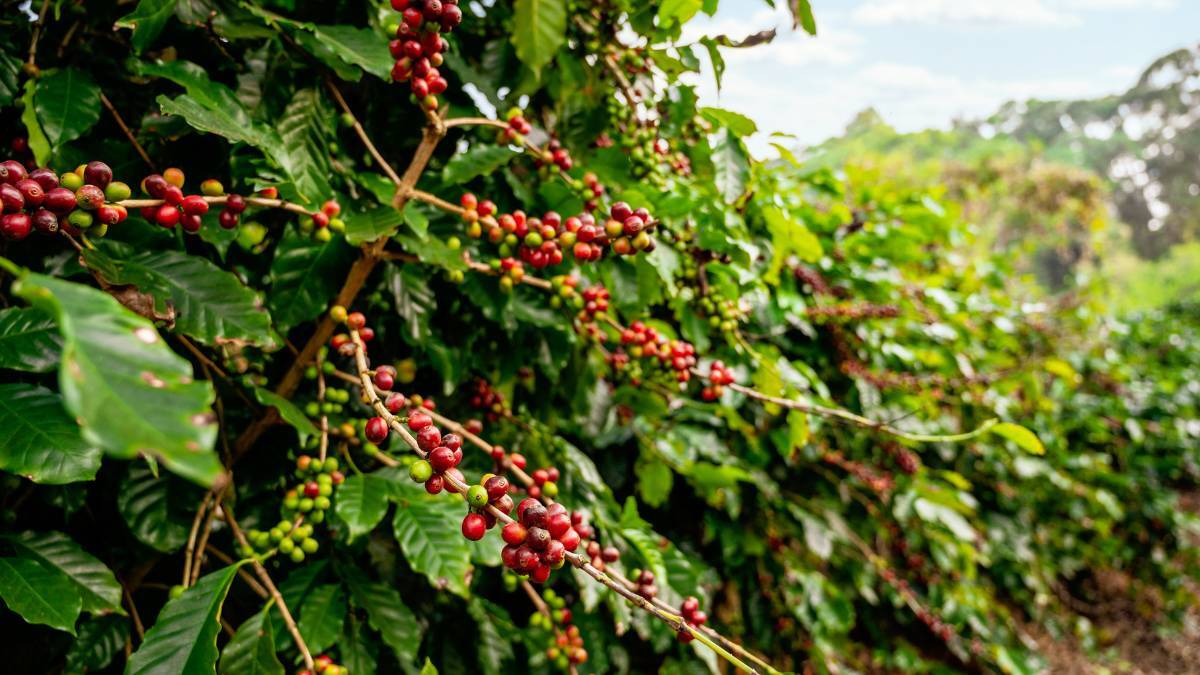
The Coffee Belt: Where Coffee is Grown
From humble origins in Africa, coffee cultivation wandered east and west, eventually forming a belt roughly bounded by the Tropics of Cancer and Capricorn. Growing regions typically offer moderate sunshine and rain, steady temperatures around 70°F (20°C), and rich, porous soil. In return, the delicate coffee tree yields beans that are an economic mainstay for dozens of countries and about 25 million people. Among natural commodities, coffee has a monetary value surpassed only by oil.

Arabica vs Robusta
There are two main varieties of coffee trees: Arabica and Robusta. Arabica trees must be grown at higher elevations and yield fewer but more flavorful beans. Robusta trees are hardier, yield more beans, and are typically used in lower-quality blends due to their stronger, more bitter profile. About 70% of the world's coffee production is Arabica.
Top 10 Coffee Producing Countries
-
Brazil (22.5 million bags)
Brazil is the heavyweight champion of coffee production, responsible for about a third of global output. Coffee was introduced from French Guiana in the early 1700s and thrives across the country. Top Coffees: Bahia, Brazil Bourbon Santos.
-
Colombia (10.5 million bags)
Colombia’s high-altitude, moist Andean climate produces some of the smoothest coffees. Top Coffees: Medellin, Colombian Supremo, Bogotá.
-
Indonesia (6.7 million bags)
Indonesia is famous for its robusta production and Arabicas from islands like Java and Sumatra. Top Coffees: Java Estate, Sumatra Mandheling, Sulawesi.
-
Vietnam (5.8 million bags)
Though coffee arrived via French missionaries in the 1860s, Vietnam's modern growth in robusta production began in the 1990s. Top Coffees: Robusta.
-
Mexico (5 million bags)
Mexico’s coffee industry is driven by small farms in the south. It is also the largest source of U.S. coffee imports. Top Coffees: Mexican Altura Coatepec, Pluma Coixtepec.
-
Ethiopia (3.8 million bags)
As the birthplace of Arabica coffee, Ethiopia plays a special role in coffee lore. Coffee is deeply embedded in Ethiopian culture. Top Coffees: Harrar Longberry, Sidamo, Yirgacheffe.
-
India (3.8 million bags)
Indian coffee is regulated by the Indian Coffee Board. Top Coffees: Mysore, Monsooned Malabar.
-
Guatemala (3.5 million bags)
Known for high-grown Arabicas, especially from volcanic regions. Top Coffees: Antigua, Atitlan, Huehuetenango.
-
Côte d'Ivoire (3.3 million bags)
Once the world's number five coffee producer, the country now primarily produces robusta for mass-market European blends. Top Coffees: Robusta.
-
Uganda (3 million bags)
Uganda’s economy relies heavily on robusta coffee, employing much of the rural population. Top Coffees: Bugisu.
Frequently Asked Questions
Where did coffee originate?
Coffee originated in Ethiopia, Africa. According to legend, it was discovered by a goat herder named Kaldi.
What are the two main types of coffee beans?
Arabica and Robusta are the two primary types of coffee beans. Arabica is known for better flavor and is grown at higher elevations, while Robusta has a stronger taste and is more resilient.
Which country produces the most coffee?
Brazil is the top coffee-producing country, contributing roughly one-third of global coffee production.
Conclusion
Coffee’s origins tell a rich story of culture, trade, and tradition spanning continents and centuries. From Ethiopia’s ancient hills to Brazil’s sprawling plantations, each growing region adds its own touch to the beans we brew. Whether you prefer the bright acidity of African coffees, the smooth balance of Latin American beans, or the bold intensity of Indonesian varieties, understanding where your coffee comes from can enrich every cup. Explore, taste, and appreciate the journey your favorite brew has taken around the world.
